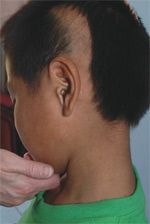Trichotillomania
A10-year-old boy was brought to a medical mission clinic in Roaring Creek, Belize, for evaluation of bald spots on his head. The mother reported that the bald areas seemed to be worsening because of the child's uncontrollable desire to pull out his hair.

A10-year-old boy was brought to a medical mission clinic in Roaring Creek, Belize, for evaluation of bald spots on his head. The mother reported that the bald areas seemed to be worsening because of the child's uncontrollable desire to pull out his hair.
Examination revealed no indication of injury, fungus, prior surgeries, or lice infestation. The child otherwise was in good health.
This child represents the classic clinical picture of trichotillomania-habitual hair-pulling that results in alopecia. Children with this disorder most commonly pull hair from the scalp, although some remove hair from the eyelashes, eyebrows, and other hairy areas on the body.1 Rarely, patients ingest the hair (trichophagia); the accumulation of hair in the GI tract can lead to complications, such as anemia and intestinal bleeding.2 Anxiety and depression are often associated with trichotillomania. This child had no history of either disorder.
Males and females of all ages, ethnicities, and socioeconomic backgrounds may have trichotillomania; however, a higher prevalence has been reported in females.3
Although currently classified as an impulse control disorder, some researchers consider trichotillomania to be an obsessive-compulsive disorder, while still others identify it as an anxiety disorder. This indefinite classification may result in misdiagnosis.4
Treatment generally consists of behavioral therapy. This includes habit reversal therapy, in which the child is taught to identify situations that trigger hair pulling, and cognitive therapy, which helps the child find alternative ways to respond to the triggering situations.4 Treatment with tricyclic antidepressants or selective serotonin reuptake inhibitors may be used along with behavioral therapy in adults, in particular those with underlying anxiety or depression5; more research is needed before these agents can be recommended for children. Because of the lack of access to medical treatment, the mother was advised to put socks on the boy's hands when she witnessed an instance of hair pulling and at night to prevent the likelihood of hair pulling.
References:
REFERENCES: 1. Franklin ME, Flessner CA, Woods DW, et al; Trichotillomania LearningCenter-Scientific Advisory Board. The child and adolescent trichotillomaniaimpact project: descriptive psychopathology, comorbidity, functional impairment,and treatment utilization. J Dev Behav Pediatr. 2008;29:493-500.
2. Grant JE, Odlaug BL. Clinical characteristics of trichotillomania with trichophagia. Compr Psychiatry. 2008;49:579-584.
3. Dia DA. “I can’t stop pulling my hair!” Using numbing cream as an adjunct treatment for trichotillomania. Health Soc Work. 2008;33:155-158.
4. Bruce TO, Barwick LW, Wright HH. Diagnosis and management of trichotillomania in children and adolescents. Pediatr Drugs. 2005;7:365-376.
5. Walsh KH, McDougle CJ. Pharmacological strategies for trichotillomania. Expert Opin Pharmacother. 2005;6:975-984.